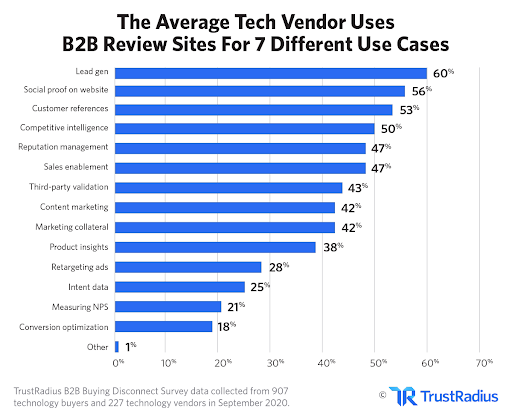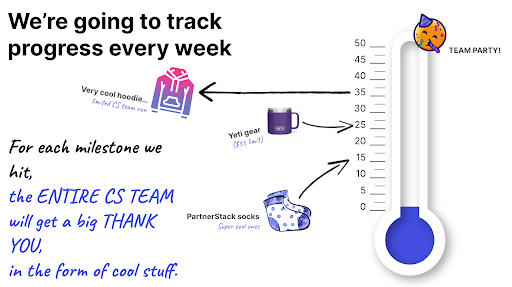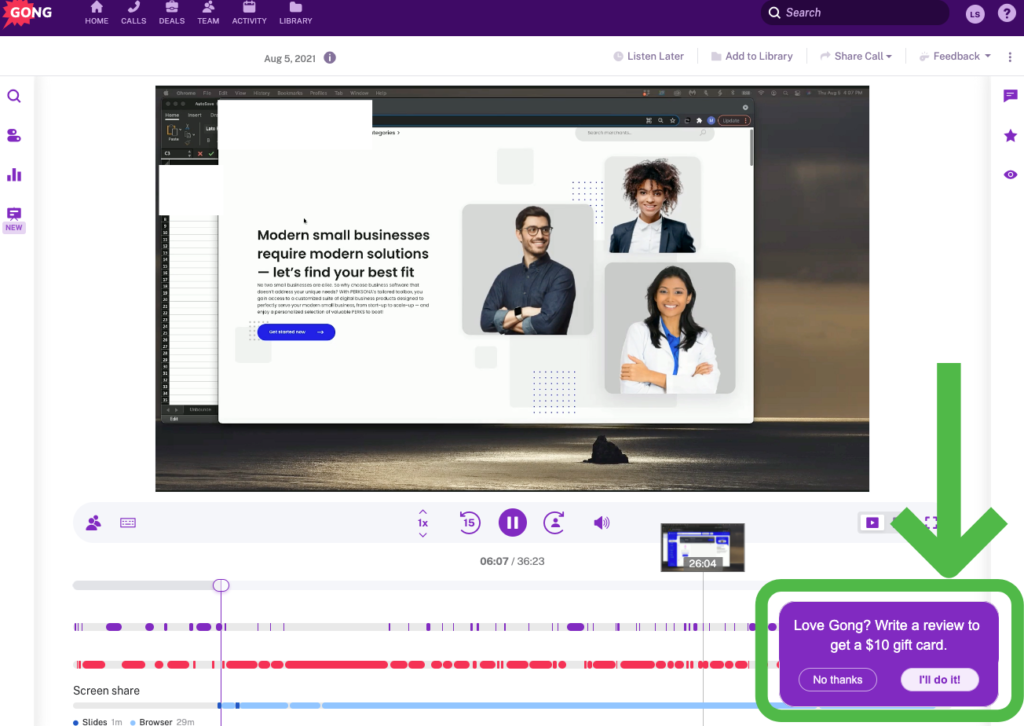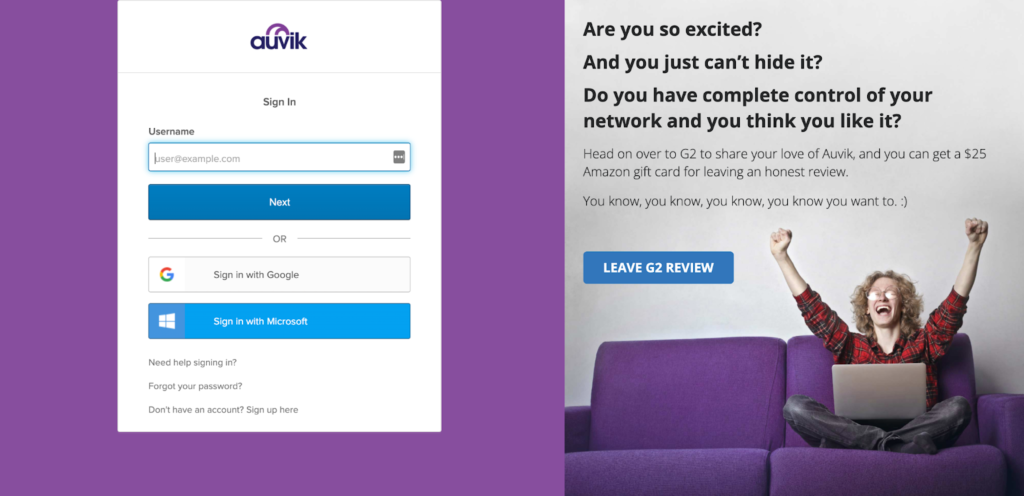After learning why online reviews matter in B2B SaaS and where buyers go for online reviews, the hard part comes: How do you generate reviews? This post introduces the strategy for generating online reviews in B2B SaaS.
It covers important factors like identifying the team responsible for this task, deciding whether to request reviews from all users or just the satisfied ones and choosing between automated or manual asks.
This guide is useful for those starting or seeking to improve their review generation strategy.
Key Findings
Review Generation Strategy in B2B Software
Some Context On How To Generate Online Reviews
There’s much to cover in a how-to guide for generating online reviews in B2B software.
When I started this site back in 2021, to determine where to begin, I ran a mini-survey to understand better what B2B practitioners want to learn on this topic.
At SaaStr Annual 2021, I hosted a “Super Braindate” on “Users Reviews in B2B SaaS: The why, the where, and the how.” Before the Braindate, I surveyed the participants to understand which pillar of online reviews most interested them: why they matter, which review sites to choose, or how to generate reviews?
Perhaps unsurprisingly, there was the most interest in how to generate online reviews.

Based on the market interest in generating online reviews in B2B software, I’ve gone deep into the nitty-gritty tactics and examples.
However, before asking for reviews, I recommend thinking through these 11 questions to guide your online review strategy and approach:
Before getting to work on reviews, I recommend thinking through these nine questions to guide your approach:
- Who makes reviews an organizational priority? Top-down or bottom-up approach to get buy-in for reviews?
- Who owns review generation? Customer Marketing, Product Marketing, Content Marketing, Demand Gen or Another Team?
- Who do you ask for reviews: all-of-your-users or advocates-only?
- When do you ask for reviews: always-on review requests or periodic review campaigns?
- Who asks for your reviews? Review-site-driven or vendor-driven?
- How do you generate reviews: manual review requests or automated review requests?
- How do you ask for reviews: incentivized vs. non-incentivized reviews?
- How many reviewers do you target at a customer account? One user review vs. a team of user reviews?
- Which channels do you use to drive reviews? Email-driven review generation or multi-channel approach?
- Quantity or quality in review generation?
- Focus on one review site or multiple?
Let’s address each strategic question about online reviews one by one.
Who sets your online reviews strategy: a top-down or bottom-up approach?
Before generating reviews, you need to get buy-in internally to do so. While you could throw caution to the wind and just get started, you’ll get a lot more out of reviews if you get buy-in from others at your company.
One question to ask is if you’re going top-down or bottom-up with your buy-in for investing resources in online reviews?
If you’re asking yourself this question, then it’s almost certain to be a bottom-up approach because those who have the power to take a top-down approach would do say without asking (Assuming they’re bought into it). If it’s top-down, it’s less about buy-in and more about sharing your vision, setting goals, and delegating responsibility to make review generation happen.
In the top-down approach, the board, a founder, or an executive prioritizes review generation as an activity and delegates it down to the functional level, to Marketing and/or Customer Success, in my experience.
In the bottom-up approach, an individual contributor, a manager, or a director makes the case to the executive team for review generation as a functional priority, if not an organizational priority and finds a way to get resources for it.
I’ve seen both approaches; as usual, the top-down approach makes things easier. However, if you’re not exec-level or up, it’s out of your control if the higher-ups decide to prioritize on their own.
The top-down approach is easier because they usually set reviews as an OKR or goal, ensuring that reviews are prioritized and resourced.
The bottom-up approach can be harder to pull off because it’s difficult, if not impossible, to measure the full value of reviews. The average tech vendor uses B2B review sites for 7 different use cases.

In the G2 and Heinz Marketing 2018 report on the Impact of Reviews on B2B Buyers and Sellers, they surveyed 548 business professionals across a range of industries and business sizes, from SMB to enterprise companies, and found six main ways that Sales and Marketing teams were putting B2B SaaS reviews to use.

Without buy-in from the top, I’ve found reviews become a passion project or get put on the back burner.
HubSpot has provided some very high-level tips on getting buy-in for your vision, like how to get people excited, get them to believe, and shape the vision as a team. Start with why reviews matter before moving on to the what or the how.
Harvard Business Review provides a little more detail on how to get your boss to buy-in. The article shows an example of a manager who finally got buy-in for his initiative when he brought in a third-party expert that his boss trusted and respected to talk about the initiative’s merits.
For B2B SaaS reviews, that might not be a bad idea if the decision-makers at your company are skeptical of the merits of reviews, and you can find someone who has done it in a similar context as yours (not a shameless plug; I am not a consultant for hire :))
Who owns review generation: Customer Marketing, Product Marketing, or another team?
Marketing-driven approaches
With so many use cases for online reviews, which team will drive reviews?
TrustRadius wrote, “Most Demand Generation marketers probably think customer reviews live with the Customer Marketing team or maybe with Product Marketing. But reviews (and data from review sites) can be powerful in the hands of Demand Generation.”
For a good reason: I suspect Customer or Product Marketing is where ownership often lies. But as a Demand Gen-focused professional, I believe Demand Gen professionals should take the lead on review generation if Customer Marketing, Product Marketing, or any other function in the business isn’t already owning review generation.
While I couldn’t find any data on ownership of business software reviews by function, in TrustRadius’s Definitive Guide to B2B Reviews, they do provide helpful guidance:
It is not unusual to see stakeholders from multiple departments come together to strategize — and benefit from — a review program. It is also important to have an executive sponsor to help guide the program and ensure support across various departments. However, you should select one person to manage the project on a day-to-day basis. Which team should run your review program?
- Customer Marketing or Customer Advocacy – if your primary goals are social proof, reference management or identifying advocates.
- Product Marketing – if your ultimate goal is sales enablement or product strategy.
- Content Marketing – if your focus is on acquiring and using authentic content.
- Corporate Communications – if you are most concerned about reputation management and brand awareness.
- Demand Generation – if your focus is driving and converting more leads.
What if you don’t have anyone in one of these roles yet?
Consider Customer Success or the function that owns the relationship with your customers.
Customer Success-driven approach
Your Customer Success team could take the lead in review generation. They can and often do play a major role in review generation because they have relationships with your users and know first-hand when it would be the right time to ask them for a review.
You can gather reviews across your CS team, from Onboarding through Support to Success.
While Customer Success Managers (CSMs) seem to often lead the way in review generation, Onboarding and Support can play important supporting roles.
Customer support leader, Zendesk, says, “Train your service teams to ask for reviews. Teach your team to recognize when it’s a good time to ask for a review, like when a customer expresses appreciation for your brand.”
Onboarding may seem too early to ask for a review, but getting a review from a new buyer in the onboarding process can still provide very helpful information for prospective buyers. Onboarding also tends to have more frequent touchpoints than CS and Support, so there’s more opportunity to find the right time to ask for the review. There are also defined milestones that could trigger review requests, manually or automatically, such as the end of Onboarding hand-off to Customer Success.
One challenge with the Customer Success-led approach is that Customer Success often has other priorities that have a more immediate and direct impact on revenue, such as upsells, cross-sells, and retention. They also tend to prioritize helping customers become successful, not helping customers share their success. And if there’s a way to get a CUstomer Marketer or team of Customer Marketers, then it’s typically CS’s preference for reviews to be owned by Customer Marketing.
While the Marketing department arguably also has things that have a more immediate and direct impact on revenue, creating social proof through reviews underpins so much of what Marketing does that there is more incentive for the Marketing team to make reviews happen. Most of the use cases for B2B software review sites are for marketing.
This prioritization challenge with CS can lead to review generation being pushed until after an advocacy program is set up, which may take months, if not years, to materialize with everything else needed in CS.
So what can you do?
If you don’t have any reviews, set a modest goal to get ten reviews. Gartner Digital Markets has found that “software product listings with 10 or more user reviews have a 2x higher conversion rate than those with no reviews.” Also, G2 uses the 10 review mark as the minimum requirement for a vendor to be added to grid comparisons, grid reports and eligible for G2 badges, as they say in their Outreach Best Practices guide.
If you already have 10 or more reviews, I recommend surveying the reviews landscape in your space, looking for opportunities, and setting a simple and quick win goal that you can build on.
Who do you ask for reviews: all-of-your-users or advocates-only?
Who should you ask for reviews: all your users or just your happiest users?
It’s a harder question to answer than it may seem. Review sites advocate for the all-your-users approach, while the vendor norm focuses on happy users.
Review sites want vendors to ask all users to maximize the number of reviews generated. This helps drive more traffic to the review site. It creates more user-generated content that review sites can sell back to vendors to use in their marketing. All-of-your-users is the moral (or ideal) high ground for creating the fullest and most truthful review picture, which helps review sites maintain the integrity of their brand while giving buyers what they want. Buyers would also benefit if all vendors took this approach to reviews.
Vendors generally want to ask their happiest users for reviews to improve their standing on review sites, as they rank vendors based on review scores and satisfaction. While vendors are keen to gather feedback from all users to improve continually, many likely feel better served by keeping praise public and criticism private. Vendors need to balance gaining a competitive advantage in review site ranking to be considered in buyer’s consideration sets and provide buyers with the user review information they want. While vendors want to help buyers, they have other stakeholders to satisfy, such as execs, founders, and boards.
There are pros and cons to each approach.
The all-of-your-users approach
There are several valid pros and cons for asking all of your users for a review.
Pros:
- Maximize the number of reviews you generate
- Provide a truer picture of your user satisfaction
- Learn from your neutral to negative reviews
- Create a more balanced review profile (research has shown that negative reviews help increase purchase decisions and that the optimal review score is between 4.2 and 4.5.)
- Comply with FTC guidance (“Don’t ask for reviews only from people you think will leave positive ones.”)
Cons:
- Decrease your review scores (ratings)
- Potentially lower your position on review sites with rankings that take into account review score listings and grids
- Create doubt in your buyer’s mind (if your review score falls below an optimal zone) and potentially weaken your position in the market (if your review score is below average). While research may show that buyers eliminate vendors if their rating is too low, it doesn’t mean your company will be included in a buyer consideration set if your rating is above their elimination rating score threshold.
- Lower your chance of inclusion in a buyer’s consideration set. B2B SaaS Reviews research found that when shortlisting vendors on review sites, 56% of B2B software buyers said they would typically consider anywhere between 3-5 vendors when on a software review site.
The happiest-users-only approach
Typically, this is a two-step process in which the first step is asking for an NPS score (1-10), and then step two is asking the promotors (i.e. those who give a 9 or 10 NPS score) to write a review.
Pros:
- Maximize your review ratings
- Address customer issues directly before they write a review
- Focus on sharing success stories of how your users are finding value in your software
Cons:
- Generate fewer reviews
- Introduce bias into your review sample by “cherry-picking” candidates
- Create doubt in your buyer’s mind (if your review profile overall is too good to be true)
- Contribute to review inflation that lowers the utility of review sites for buyers
To make this difficult decision, weigh the pros and cons to the best of your ability and decide which approach you will take.
When do you ask for reviews: always-on review requests or periodic review campaigns?
An always-on approach sees review generation as an ongoing initiative.
A campaign approach has a start and a stop that’s usually driven by a trigger event, such as an upcoming seasonal G2 report, or one or more of your competitors making a push for reviews.
One advantage of a campaign approach is it’s easier to set up than an always-on approach. It can be as easy as assembling a list of users and emailing them with a review request, which you can do or a review site will happily do for you. Also, by generating more reviews nearer a review deadline, the lower decay score your reviews will have, which means the review recency will boost your performance in quarterly review reports.
To keep things simple, start with a campaign approach, learn what does and does not work, and then decide if and how you can set up an always-on approach to review generation.
The always-on approach has the advantages of efficiency and timeliness.
This approach is more efficient because reviews are generated once it’s set up with the limited need for your personnel time. Also, some users will look at the trend line of reviews for a product and prefer to see a steady stream instead of a spike in reviews.
Timing is everything. This adage applies to review generation, too. G2 recommends setting up automatic triggers based on user milestones for always-on review collection. Asking for a review at the wrong time could be awkward.

It’s also worth noting that the two approaches are not mutually exclusive. In other words, you can take an always-on approach to reviews and layer on a review campaign to provide an added push at quarter-end.
Who asks for your reviews: review-site driven or vendor-driven?
Review-site driven approach
B2B software review sites are keen to offer reviews-as-a-service (RaaS) to vendors because more online reviews on their site would mean more traffic to the reviews site as Google and other search engines rank sites with review content highly. This increase in online reviews increases the site’s importance for the vendor and the category.
It can be a win-win for review sites and vendors because review site-driven campaigns are an easy way to generate reviews quickly with limited time investment.
The downside of a review site-driven campaign is the conversion rate tends to be lower. The vendor-buyer relationships can be an important reason users take the time to write a review. So when the user is asked for a review by their point of contact at the vendor, they can feel more compelled to help them out than if the ask came indirectly from a review site.
Here’s what a typical review-site-driven approach would look like: You send your list of review candidates to the review site (e.g. G2), and the review sites does the rest, i.e. the review site sends your users email sequences with gift card incentives, and send the gift cards to reviewers.
A vendor-driven approach is simply vendors asking their users for reviews directly, which allows for more control over the process of who to ask, when to ask, and how to ask.
You can try combining the two, with the review site asking the broad user base and the vendor asking the top users directly.
Vendor-driven approach
A vendor-driven approach is simply asking their users for reviews directly, which allows for more control over the process of who to ask, when to ask, and how to ask.
You can combine the two, with the review site asking the broad user base and the vendor asking the top users directly.
How do you generate reviews: manual review requests or automated review requests?
Manual vs. Automated review requests
There are pros and cons to each.
A manual approach to asking for online reviews allows you to personalize the ask and wait for the right moment to ask, but it’s time-intensive and hard to sustain.
Conversely, an automated approach lightens the review lift so you can maintain an always-on approach to review generation. Still, your request-to-review rate will be lower as the request lacks personal touch.
One middle ground is to automate the nudge to the review requester at your organization, like a CSM, rather than the review request itself. This allows you to automate triggers based on user milestones that remind your teammate to ask for the review at the right time while also providing the added personal touch that a manual approach can afford, like waiting to ask for the review until the upcoming meeting between CSM and the user review candidate.
With automation, you can leverage marketing automation platforms to create workflows with if/then logic. For example, you can create a workflow where if someone is added to a list (because they triggered a user milestone like an NPS response, renewal, etc.), then send them a review request. If they don’t respond within two weeks, then send them a follow-up review request reminder.
Zapier can be a big help in tying your systems together.
Say you have NPS data in Wootric, HubSpot as your marketing platform, G2 as the review platform, and Slack as your internal communication platform, you can use Zaps to create a workflow that triggers an NPS response to be added to a HubSpot list that is used to send an email request that if it leads to a G2 review the G2 reviews data is sent to a Slack channel to inform your team of the review.
Alternatively, you can use the NPS response to trigger the message to the Slack channel and tag the right person, like a CSM, to ask for a review manually with a personal touch.
Note: in this HubSpot workflow example, there are “no triggers set” for the “contact enrollment trigger” because “you don’t need to set enrollment triggers if you’ll only be manually enrolling records in a workflow or enrolling records through another workflow’s Enroll in another workflow action.” In this example, the Zap adds the contacts.
How do you ask for reviews: incentivized vs. non-incentivized reviews?
In B2B, review sites allow incentives for reviews because they find small thank-you rewards offered for honest reviews help reduce participation bias.
Incentivization of reviews in B2C seems more problematic because there isn’t as strong of a process to block fake reviews. If a toothbrush maker offers $10 to review one of their toothbrushes, they will generate some reviews from people who have never used the toothbrush but say they do.
In B2B, the main software review sites have thorough review approval processes. These include a step in which the reviewer must prove that they are a user by logging into the system under review and taking a screenshot of the software while logged in.
In G2’s Review Playbook, they say that “providing customer incentives, like gift cards, are proven to result in reviews” (though they also add that you should not overlook organic, i.e. non-incentivized, review collection approaches, too).
TrustRadius found that non-incentivized reviews tend to be from the users at the extremes, which buyers often filter out, and that invitations and small incentives increase participation from the users in between.
In my experience, review site vendors recommend between $10 and $50 in the way of gift cards as a small incentive directly from the review site to the user on behalf of the vendor.
As a vendor, you can also consider a two-sided or double-sided incentive. You might have experienced this with referrals, where both the referrer and the referee get an incentive for the referee to take the action. E.g.“Give 10, Get 10”. Refer a friend and we’ll give them a $10 credit to get started, and when they sign up for an account, we’ll also give you a $10 credit, too.” ReferralCandy notes how this review approach taps into the persuasion principle of reciprocity: when you get something, you want to give something in return. A two-sided incentive is set up to do just that.
With 1:1 review invitations, consider making the incentive two-sided, so the review requester, like a CSM, and the user reviewer each get an incentive for a review. This adheres to the guideline to keep the incentive small for the user reviewer while providing a small incentive to the requester to make the time and effort and use their relationship capital to ask their customer for a review.
Create a campaign or competition for your internal team that asks for reviews
You could incentivize your colleagues to generate reviews in several ways.
If your team is more collaborative, make a campaign with group goals and incentives.
If your team is more competitive, make a campaign that provides bigger incentives to the top individual performers.
For example, in a review generation competition, you can provide all the incentives to the top 3 people who generate the most reviews, as you would for Sales Club.
Alternatively, you can set it up more like a campaign for everyone to collaborate and share the rewards with the whole team when they collectively hit review goals. For example, when they collectively generate 25 reviews, they get exclusive company swag; when they generate 50 reviews, they get a team party.
At PartnerStack, we’ve done both. At first, we offered gift cards to individual employees, mainly on the Customer Success team, who generated a review. Then we shifted to a collaborative competition that provided the Customer Success team with incentives when they collectively hit review generation milestones.

Incentives direct from vendors to users
Advocate Marketing creator Influitive has made a business of helping B2B SaaS companies generate reviews (and references and referrals).
Many customers have successfully used “gamification” in their review generation process. i.e. the vendors provide points to their advocates in exchange for acts of advocacy, such as the advocate writing a review.
Vendors can get creative with what they offer in exchange. For example, Influitive customer BMC advocates were awarded points that they could redeem for prizes like branded swag, 1:1 time with a BMC executive, or BMC educational courses. (Note: while Influitive makes it easy to offer multiple types of incentives at scale, try to do it manually at first to see if it works at your current level. If it does, then consider adding technology to help you scale).
Another way to thank reviewers is to send them swag or a thoughtful gift (potentially leveraging one of the direct mail platforms like Sendoso, Alyce, Reachdesk, or Postal).
How many reviewers do you target at a customer account: one person or a team?
The typical approach to review generation is to approach individuals and ask them for a review. In this way, review generation is like lead generation. The goal is to get one person to take an action.
But there’s another, less common approach to review generation that’s more like the account-based marketing approach: asking a team of users at a customer account. With this approach, you ask the team of users, not just one user, to provide a review for you. While it’s harder than the individual approach, you can expand your review generation pool by reaching beyond your main point of contact at an account. Also, your main point of contact could help you get reviews from your teammates.
When I was at LevelJump, they succeeded with an account-based review generation approach. They were able to leverage the relationship strength between the CSM and the main point of contact to extend review collection to the main point of contact’s wider team. It wasn’t easy, but it proved effective with patience, persistence, and a great CSM who would hit a Founder-created goal of getting a certain number of customer reviews each quarter.
Which channels do you use to drive reviews: email-driven review generation or multi-channel approach?
Email review requests
Most review generation is email-driven. In most, if not all, cases, an email will be either the channel or one of the channels used in review generation.
Whether using a list for a one-off email or an automated workflow to trigger email sends based on user milestones, email is an effective channel to get reviews.
In-app review requests
A less common approach to review generation is to use in-product or app messages to request reviews.
While it may be a less common approach, in-app requests can be highly effective. One reason why it’s less common is that it’s simply harder to pull off. One person can request an email with permission to email a list of users. An in-product review request message likely requires more effort and coordination because the product experience has more stakeholders than email.
But if you can pull off in-product messages, they can be a great way to collect reviews.
If you’re in a go-to-market role at a company that uses Gong, you’ve likely seen this pop-up request (see image) to write a review on Gong and get a $10 gift card.
Gong was rated #1 in G2’s Best Software Products of 2021. To top the charts, in the calendar year of 2021, Gong consistently drove dozens of reviews on G2 each month, with some added review spikes throughout the year. One way they did it was with this in-app review request message.

Another way to generate reviews while your users use your software is to ask for a review on your application’s login page, as Aukik is asking for G2 reviews.

Other Channels For Review Requests
Beyond email and in-app messages for review generation, you can also try:
- Slack / instant messaging
- Message your users for reviewers wherever you already have an open dialogue
- Zoom calls
- For some, it may feel more natural to bring up reviews on a Zoom call with the user, after the user has just expressed their satisfaction with you as a vendor
- Social media posts
- If you’re looking to cast a wide net, you could ask you users who follow you on social media for a review
- Review booths at user conference events
- For companies that are larger enough to host their own user conferences, a review booth at a user conference can be a great way to generate reviews.
- Oracle Analytics had a G2 review booth at Kscope, a 3,000 person Oracle user group event, and they generated 154 reviews in two days, a 200% increase in reviews for them.
- Conversational marketing
- If you have conversational marketing on your website, you can leverage it for reviews. For example, you can trigger an automated chat prompt for users that land on your site who are customers and haven’t provided a review yet (by using the data you have in your CRM integrated with your conversational marketing.)
What's more important in online review generation: quantity or quality?
When generating online reviews, companies often navigate the delicate balance between quality and quantity. This balance is crucial because while many reviews can enhance visibility and credibility, the quality of those reviews significantly impacts consumer perception and decision-making.
From the perspective of review sites, a “quality” review is typically in-depth and impartial. Such reviews offer detailed insights into the product or service, covering various aspects like functionality, usability, customer support, and value for money. They often include pros and cons, providing a balanced view that helps potential customers make informed decisions. In-depth reviews also tend to be more engaging and trustworthy, reflecting genuine user experiences rather than superficial or biased opinions.
On the other hand, vendors usually view a “quality” review as one with a high rating, typically around 4.5 or above out of 5. These reviews are seen as endorsements of their products or services, enhancing their reputation and attractiveness in the market. High-rated reviews can increase consumer trust and, consequently, higher conversion rates.
To strike the right balance, companies should focus on encouraging honest and detailed feedback from a diverse range of customers. This approach ensures a mix of ratings and leads to a variety of perspectives being shared, which is valuable to both potential customers and the company itself.
Where do you get reviews: one review site or multiple review sites?
In B2B SaaS, there are ten main software review sites to consider.
Deciding whether to gather customer reviews on one platform or across multiple sites is crucial for businesses. Each approach has its merits.
Single Review Site Focus
- Concentrated Impact: Focusing on one site allows for a deeper engagement and stronger presence. For instance, Reachdesk, a Series B SaaS company, focused only on G2 and got over 500 reviews to rank as the 5th fastest-growing vendor on G2, an accolade that earned them much attention.
- Simplified Management: Managing reviews is easier on a single platform, ensuring a consistent brand voice.
- Limitations: This approach risks limited reach and over-dependence on one site’s policies and popularity.
Multiple Review Sites Strategy
- Broader Reach: Spreading reviews across various platforms increases visibility among a diverse audience. your buyers will turn to more than one review site, so there’s a benefit in showing up well on each review site your buyers turn to.
- Increased Credibility: A strong presence on multiple sites enhances trust and credibility.
- Resource Demands: This approach requires more resources and could lead to diluted efforts without a strong presence on any site.
Next Steps: How To Generate Reviews
Now that you know how to set your review generation strategy, the next step is to turn to tactics. Learn how in this post, How To Generate Online Reviews: Tactics To Get More Reviews In B2B Software.
Author
-

I'm the Founder and Editor-In-Chief of B2B SaaS Reviews and the Director of Demand Generation at PartnerStack, the leading platform for partner management and affiliate marketing in B2B SaaS. My experience spans several notable B2B SaaS companies, including Influitive (Advocate Marketing), LevelJump (Sales Enablement, acquired by Salesforce), and Eloqua (Marketing Automation, acquired by Oracle). I hold a Bachelor of Commerce in Marketing Management from Toronto Metropolitan University and a Master of International Business from Queen's University, with academic exchanges at Copenhagen Business School and Bocconi University.





